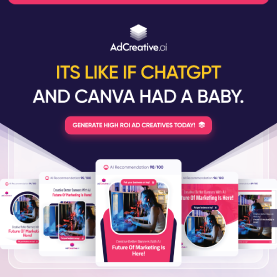How AI Web Analytics Platforms Drive Growth for Digital Entrepreneurs
I’ll never forget the first time I got a taste of what AI-powered analytics could really do. I had just launched a niche blog, pouring countless hours into creating high-value content and crafting a sleek design. But despite all my efforts, the traffic just wasn’t there. Traditional analytics tools gave me raw numbers—pageviews, bounce rates—but what I needed was a roadmap. Enter AI-driven analytics, and let me tell you, it was like flipping on a light in a pitch-black room.
Here’s the thing: AI platforms don’t just tell you what’s happening; they tell you why it’s happening and what to do next. For example, when I integrated an AI-powered tool (think platforms like Amplitude or Mixpanel), it flagged that visitors were bouncing right after landing on my “About” page. Traditional analytics would have left me guessing, but the AI platform dug deeper, suggesting that users weren’t finding the content engaging. It even recommended restructuring the page with bullet points and adding a CTA for my newsletter—game changer.
Lessons From the Trenches: Insights That Stick
One of the most eye-opening features of these platforms is predictive analytics.

Imagine being able to forecast which blog topics will resonate most with your audience based on historical data. I once wrote a piece about email marketing, expecting moderate traffic. The AI had flagged a spike in searches for related terms and suggested optimizing for those keywords. That blog post became one of my top performers, driving a 40% uptick in newsletter sign-ups over a single quarter. That’s the kind of insight that moves the needle.
Another huge win? Automated anomaly detection. One morning, I got an alert that my landing page conversions had dropped by 25%. The AI traced it back to a broken link in my CTA button. Without that notification, I could’ve lost weeks of potential leads before spotting the issue.
Actionable Takeaways for Digital Creators
- Start with clear goals. Whether it’s increasing engagement, driving sales, or growing your email list, know what you want to measure before diving into any platform.
- Lean on personalization features. Use AI insights to tailor content or offers for specific audience segments. It’s all about meeting users where they are.
- Don’t ignore anomalies. Treat every alert as an opportunity to learn and optimize.
AI analytics platforms are like having a seasoned mentor whispering actionable advice in your ear. Trust me—once you tap into their full potential, there’s no looking back.
Key Features to Look for in AI Web Analytics Platforms
When it comes to choosing the right AI web analytics platform, it’s like picking the ultimate business partner. You’re looking for something that works smarter, not harder, and grows with you every step of the way. Over the years, I’ve tested a handful of these platforms, and let me tell you—some shine, while others… not so much. Here’s what I’ve learned about the must-have features you can’t afford to overlook.
1. AI-Driven Insights: Your Crystal Ball for Growth
The magic of AI analytics lies in its ability to do what traditional tools can’t: predict the future. A solid platform leverages predictive analytics to spot trends before they hit. I’ll never forget the time I launched a product, thinking I knew my audience inside out. Turns out, I didn’t—but the AI flagged emerging interest in a related category I hadn’t considered. Pivoting based on that insight netted me a 20% revenue bump in a quarter. Look for platforms that don’t just report what happened—they help you see what’s coming.
Another essential? Automated anomaly detection. This feature has saved me more than once. Imagine waking up to a 50% traffic drop and having no idea why. With a solid AI tool, I got an alert pinpointing a misconfigured meta tag. Fixed it within minutes. Without that nudge, I’d probably have lost weeks trying to troubleshoot.
2. Personalization Capabilities: The Secret Sauce
Let’s face it—personalized experiences win every time. Platforms that recommend tailored content based on user behavior are worth their weight in gold. When I integrated AI-driven personalization, engagement skyrocketed. Visitors started sticking around longer, and my bounce rate dropped by 15%. It’s all about serving the right content to the right people at the right time.
3. Ease of Integration: No Headaches, Please
You want a tool that plays nice with your existing stack—whether it’s your CRM, CMS, or email marketing platform. I’ve learned this the hard way after struggling with a platform that didn’t sync properly with my email software. Don’t make my mistake. Look for seamless compatibility with your tools from day one.
4. User-Friendly Interfaces: Keep It Simple
A complicated dashboard is a deal-breaker. Even if you’re tech-savvy, your team might not be. Choose a platform with intuitive dashboards and clean visuals so everyone—from data geeks to creatives—can make sense of the insights.
5. Scalability and Security: Plan for Growth
Finally, make sure your platform can scale with your business. As your traffic grows, so does your data. Bonus points if the platform adheres to GDPR and CCPA—because trust is non-negotiable.
Picking the right AI web analytics platform can be a game-changer. Focus on these key features, and you’ll set yourself up for long-term success.
Benefits of Using AI Web Analytics Platforms
If there’s one thing I’ve learned on my entrepreneurial journey, it’s this: data is everything. But not all data is created equal, and how you interpret it can make or break your business. That’s where AI web analytics platforms come in. These tools are like having a crystal ball for your website, turning mountains of numbers into clear, actionable insights. Here’s why they’re an absolute game-changer.
1. Enhanced Decision-Making: Clarity in the Chaos
Let’s be honest—running a digital business can feel like navigating a maze blindfolded. I used to spend hours poring over analytics reports, second-guessing every decision. But with AI-driven platforms, the guesswork is gone. These tools provide real-time insights and actionable recommendations, so you know exactly what’s working and what isn’t. For example, when my email sign-ups plateaued last year, the AI flagged that my CTAs weren’t optimized for mobile users. A quick tweak boosted conversions by 18%. That’s the power of AI cutting through the noise.
2. Improved User Experience: Make Visitors Feel Seen
If there’s one thing we know about today’s users, it’s that they demand personalization. AI platforms excel at creating tailored user journeys by analyzing behavior patterns and preferences. I’ll never forget the time I implemented AI-driven recommendations on my e-commerce site. Suddenly, customers were seeing products they actually wanted, and my cart abandonment rate dropped by 12%. The feedback? “It’s like you’re reading my mind.” Yep, mission accomplished.
3. Time and Cost Efficiency: Do More With Less
Time is money, especially when you’re scaling. Before AI, I was drowning in repetitive tasks—manual data pulls, report formatting, you name it. Now, automation handles the grunt work, freeing me to focus on strategy. The savings aren’t just in hours but in dollars, too. Automating customer segmentation alone shaved $1,000 off my monthly expenses.
4. Predictive Analytics: Stay Ahead of the Curve
This is where things get really exciting. AI platforms don’t just tell you what happened—they predict what’s next. For instance, when launching a new blog series, the AI suggested topics poised to trend based on recent searches. That insight gave me a 25% traffic boost before my competitors even caught on.
5. Error Reduction: No More Costly Mistakes
We’ve all had those “oops” moments—like the time I accidentally ran a campaign with a broken link (yikes). With AI-driven anomaly detection, those errors are flagged immediately. It’s like having a safety net for your analytics, saving you from costly blunders.
In short, AI web analytics platforms aren’t just tools—they’re your secret weapon. They help you work smarter, connect deeper, and grow faster. If you’re not using one yet, what are you waiting for?
The Best AI Web Analytics Platforms (2025 Edition)
Choosing the right AI-powered analytics platform can feel overwhelming, especially with so many great options out there. Each platform shines in its own way, depending on your business size, goals, and budget. To help you make an informed decision, here’s a breakdown of the top AI web analytics platforms of 2025, along with a handy comparison of their standout features and pricing.
1. Google Analytics 4 (GA4) with AI Capabilities
- Features: Predictive metrics, automated insights, seamless integration with Google tools like Ads and Search Console.
- Best For: Small to large businesses looking for a free or affordable analytics solution.
- Pricing: Free (premium upgrades available).
- Why Choose GA4: Perfect for beginners and budget-conscious entrepreneurs who want powerful analytics without breaking the bank.
2. Adobe Analytics
- Features: Advanced AI-driven segmentation, multi-channel tracking, robust reporting tools.
- Best For: Enterprises and marketing professionals managing complex campaigns.
- Pricing: Custom quotes available.
- Why Choose Adobe Analytics: Ideal for large organizations that need precision and depth in their analytics.
3. Piwik PRO Analytics Suite
- Features: Privacy-focused, customizable dashboards, advanced segmentation for granular insights.
- Best For: Businesses prioritizing data privacy and compliance (e.g., GDPR, HIPAA).
- Pricing: Free plan available; premium options for advanced needs.
- Why Choose Piwik PRO: A great pick for privacy-first organizations.
4. Mixpanel
- Features: Behavioral analytics, AI-driven insights, real-time reporting.
- Best For: SaaS companies and mobile app developers.
- Pricing: Free plan available; premium starts at $25/month.
- Why Choose Mixpanel: Tailored for startups and developers focused on user behavior and retention.
5. Heap
- Features: Automatic data capture, AI-powered analysis, user-friendly interface.
- Best For: Businesses seeking in-depth insights into user journeys.
- Pricing: Free plan available; custom pricing for enterprises.
- Why Choose Heap: Perfect for understanding every touchpoint in the customer journey.
6. Crazy Egg
- Features: Heatmaps, scroll maps, user session recordings, AI overlays for recommendations.
- Best For: UX designers and website optimization teams.
- Pricing: Plans start at $29/month.
- Why Choose Crazy Egg: The go-to tool for visualizing how users interact with your site.
7. Matomo (formerly Piwik)
- Features: Open-source platform, AI-based analytics, high customization.
- Best For: Businesses needing full control over their analytics data.
- Pricing: Free for self-hosted; cloud-hosted plans available.
- Why Choose Matomo: Ideal for businesses that value ownership and flexibility.
8. Kissmetrics
- Features: Customer journey analysis, AI-driven predictions, robust reporting.
- Best For: E-commerce and subscription-based businesses.
- Pricing: Plans start at $299/month.
- Why Choose Kissmetrics: Designed to help you understand and optimize every stage of the sales funnel.
Comparison Table
| Platform | Best For | Key Features | Pricing |
|---|---|---|---|
| Google Analytics 4 | All business sizes | Predictive metrics, Google integration | Free (premium available) |
| Adobe Analytics | Enterprises | Multi-channel, robust AI segmentation | Custom quotes |
| Piwik PRO | Privacy-focused businesses | Customizable, privacy compliance | Free plan; premium options |
| Mixpanel | SaaS and mobile apps | Behavioral analytics, real-time reporting | Free; from $25/month |
| Heap | User journey insights | Automatic data capture, AI analysis | Free plan; custom pricing |
| Crazy Egg | UX designers, website optimization | Heatmaps, AI overlays | From $29/month |
| Matomo | Businesses needing control | Open-source, customizable | Free (self-hosted); paid |
| Kissmetrics | E-commerce, subscription models | Customer journey analysis | From $299/month |
With this lineup, there’s a platform for every type of digital entrepreneur. Whether you’re focused on privacy, scalability, or predictive analytics, one of these tools will help you level up your strategy. The question is, which one fits your needs best?
How to Choose the Best AI Web Analytics Platform for Your Needs
1. Identify Business Goals
Align platform capabilities with your specific objectives, such as increasing conversions, improving UX, or boosting customer retention.
2. Evaluate Data Privacy Requirements
Ensure the platform complies with data privacy regulations like GDPR and CCPA, especially if handling sensitive customer data.
3. Consider Scalability
Choose a solution that can grow alongside your business to avoid the need for frequent migrations.
4. Budget and ROI
Assess pricing plans against the expected benefits to ensure the platform delivers value.
Common Challenges When Using AI Web Analytics
- Data Overload
- Managing and interpreting vast amounts of data can be overwhelming without proper filtering tools.
- Implementation Complexities
- Integration with legacy systems and training staff can pose initial challenges.
- Trust in AI Recommendations
- Building trust in AI-driven insights requires transparency in the algorithms used.
- Privacy Concerns
- Ensuring ethical use of data while adhering to regulations is crucial.
Future of AI in Web Analytics
Emerging Trends
- Voice and Visual Data Analytics: Enhanced analysis of user interactions through voice commands and visual data.
- Integration with IoT and AR/VR: Expanding capabilities to analyze data from emerging technologies.
Predictions for 2025 and Beyond
- Increased adoption of AI-driven analytics across industries.
- Enhanced personalization and predictive accuracy to meet customer expectations.
Conclusion
AI-powered web analytics platforms are revolutionizing how businesses analyze and act on their data. From predictive analytics to real-time insights, these tools are essential for staying competitive in today’s digital-first world. Whether you’re a small business or a global enterprise, there’s an AI analytics platform suited to your needs.
Ready to take the next step? Explore the platforms mentioned and find the perfect fit for your business. Need more guidance? Download our free comparison guide or book a consultation today!


